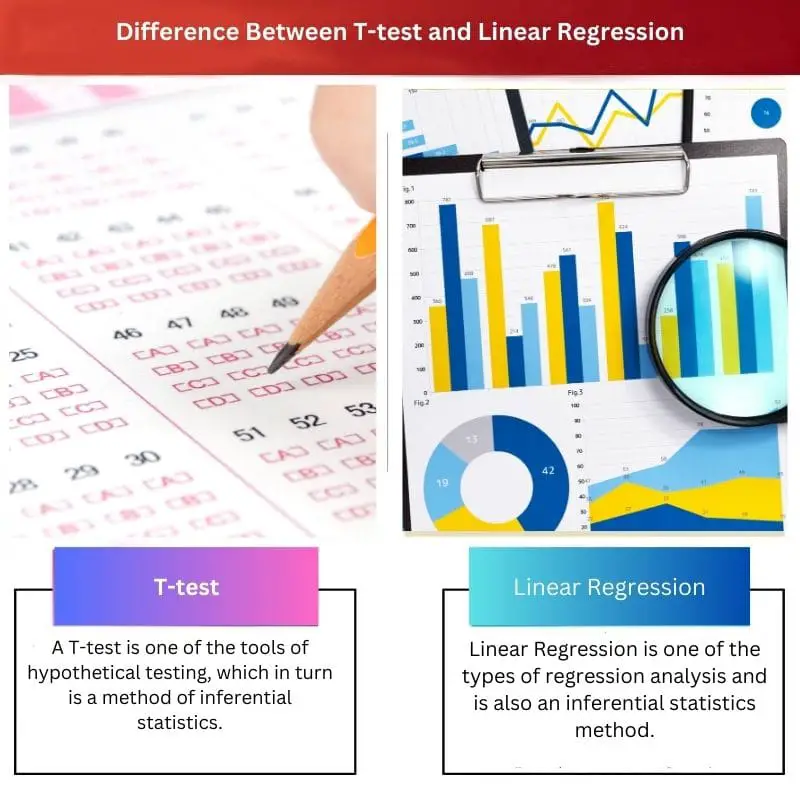T-test and Linear regression are terms related to inferential statistics. The statistical method helps us generalise and predict a population by taking a small but illustrative sample.
Key Takeaways
- A t-test is a statistical test used to compare the means of two groups. At the same time, linear regression is a method for modeling the relationship between a dependent variable and one or more independent variables.
- T-tests help determine if differences between groups are significant, whereas linear regression can predict the value of a dependent variable based on independent variable values.
- T-tests are limited to comparing means, while linear regression can model complex relationships and control for confounding variables.
T-test vs Linear Regression
The difference between T-test and Linear Regression is that Linear Regression is applied to elucidate the correlation between one or two variables in a straight line. At the same time, T-test is one of the tools of hypothesis tests applied to the slope coefficients or regression coefficients derived from a simple linear regression.

While T-test is one of the tests used in hypothesis testing, Linear Regression is one of the types of regression analysis.
A T-test is one of the hypothesis tests conducted to determine whether the difference between the averages of two groups is remarkable or not, that is, whether those differences may have happened by chance.
Comparison Table
| Parameter of Comparison | T-test | Linear Regression |
|---|---|---|
| Statistical Method | A T-test is one of the tools of hypothetical testing, which in turn is a method of inferential statistics. | Linear Regression is one of the types of regression analysis and is also an inferential statistics method. |
| Usage | A T-test is used to compare the means of two sets of observed data and to find to what extent such difference is ‘by chance’. | Linear Regression is used to find the relationship between one dependent or outcome variable and one or more independent or predictor variables. |
| Types | T-tests are mainly of three types, namely Independent Sample t-test (comparison between the average of two sets of data), paired Sample T-test (comparing the standards of identical sets of data as different intervals) and One Sample T-test (comparing the average of the single set of data with a known mean). | There are two Linear Regression types: Simple Linear Regression (comprising one dependent and one independent variable) and Multiple Linear Regression (consisting of one dependent variable and two or more independent variables). |
| Practical Applications | The T-test can be used to test the returns from two different portfolios managed under two different investment strategies. It was first used to check the consistent quality of stout in a brewing company. | Linear Regression is mainly used for observing customer behaviour, pricing, forecasting sales for a company, weather, GDP growth etc. |
| The number of variables or sets that can be used. | Only two sets of data or groups can be used in a T-test. | While there is only one regressand, the number of regressors can be more than two. |
What is T-test?
A T-test is one of the instruments used in hypothesis testing for comparing two different sets of data and their means or averages.
It was used for the first time by William Sealy Gosset, a chemist who worked for a brewing company named Guinness, to monitor the consistent quality of the stout.
Gradually, it was upgraded, and now it refers to any hypothesis tests in which the data, when analyzed, is supposed to be equivalent to a t-distribution (a bell-shaped distribution curve with heavier tails) if the null hypothesis (the assumption that no relationship exists between the sets of data) proves to be correct.
There are three types of T-tests:
- Independent Samples T-test: It is used to compare two different sets of observed data and their means.
- Paired Sample T-test: It compares the average of a single set of observed data at different times.
- One Sample T-test: It compares the mean of a single set of data and a known standard.
As an approach for testing the hypothesis, T-test is quite conservative. It can be applied to only two data sets and is suitable for only small ones.

What is Linear Regression?
Linear Regression is a method of inferential statistics that tries to explain the correlation between a dependent variable(Y) and one or more independent variables(X) using a straight line.
- Does a set of explanatory variables correctly predict the outcome variable?
- If it does, then which are the most prominent independent or explanatory variables significantly affecting the dependent or outcome variable?
- And lastly, to what extent does a change in these independent or explanatory variables affect the outcome or dependent variable?
Similarly, a relationship between the dependent and the independent variable is said to be harmful if the former decreases with an increase in the latter.
Linear Regression has three usages:
- For deciding the strength of independent variables, i.e. to what extent they influence the independent variable.
- For forecasting the change in the dependent variable induced by the independent variables.
- For predicting future trends and values.
There are mainly two linear regressions: Simple Linear Regression which consists of one dependent variable and one independent variable, and Multiple Linear Regression, which comprises the dependent variable and two or more independent variables.

Main Differences Between T-test and Linear Regression
- The main difference between a Linear Regression and a T-test is that Linear Regression explains the correlation between a regressand and one or more regressors and the extent to which the latter influences the former.
- Linear regression analysis can be done even with larger data sets, but a T-test is suitable for only smaller data sets.

- https://www.banglajol.info/index.php/JSR/article/view/9067
- https://injuryprevention.bmj.com/content/4/1/52.short
I’m not quite sure these concepts were explained well enough. It might be too complex for some readers to understand.
I respectfully disagree. I think the explanations were thorough and clear, catering to a wide audience.
The article provides a clear and informative explanation of both T-test and Linear Regression. It’s useful for anyone interested in inferential statistics.
This is a great overview of the concepts. Well written and easy to understand.
I completely agree! It’s a very comprehensive explanation that can definitely benefit anyone who wants to learn more about inferential statistics.
The article presents a well-structured comparison between T-tests and Linear Regression, making it easy for readers to grasp the key differences.
Agreed. I found the comparison table to be particularly useful and well-organized.
The structured approach to comparing these statistical methods is commendable.
I found the article to be informative and well-written, providing valuable insights into the topics discussed.
Absolutely, the insights provided here are indeed valuable. Well worth the read!
The article seems a bit too simplistic and does not dive deep into the complexities of these statistical methods.
I can see how one might perceive it as simplistic, but sometimes a straightforward explanation is the best approach for such concepts.
I think the simplicity of the explanations is what makes this article effective. It’s not lacking in depth, but rather concise and comprehensible.
I find this article very enlightening and feel like I’ve learned a lot from it. Great job on explaining these complex terms in a simple manner!
Definitely! The author did a fantastic job of simplifying these concepts for the readers. It’s a valuable read.
This article is a bit too verbose and might overwhelm readers with unnecessary details.
I appreciate the thoroughness of the article. It’s important to ensure that all aspects are adequately explained.
I don’t think it’s verbose; it thoroughly covers the essential aspects of T-test and Linear Regression.
Finally, a well-explained article on T-tests and Linear Regression. The comparison table is especially helpful for understanding their differences.
Absolutely! The comparison table really simplifies the contrasting aspects of these statistical methods.
The article lacks substance and fails to engage its readers effectively.
The article provides excellent insights into T-test and Linear Regression and their practical applications. A valuable resource indeed.
I couldn’t agree more! The practical applications provided here are very informative.